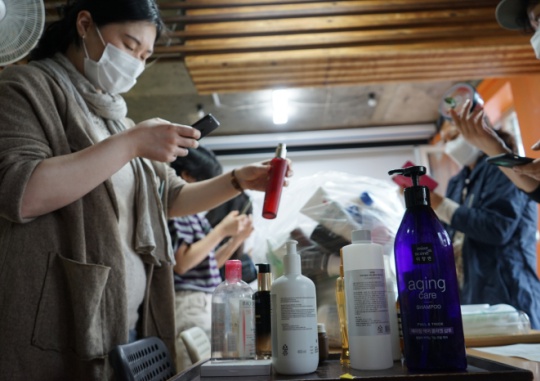Don't Trust the Recycling Symbols on Cosmetic Containers
이 글자크기로 변경됩니다.
(예시) 가장 빠른 뉴스가 있고 다양한 정보, 쌍방향 소통이 숨쉬는 다음뉴스를 만나보세요. 다음뉴스는 국내외 주요이슈와 실시간 속보, 문화생활 및 다양한 분야의 뉴스를 입체적으로 전달하고 있습니다.
[경향신문]

Here is an empty white lotion bottle, washed clean. Near the bottom of the bottle, there is a recycling symbol along with the letters PET indicating the material used to make the bottle. The bottle pump is made of “OTHER” materials meaning composite materials, and the lid is made of PP (polypropylene). The materials in the bottle are specified and the recycling symbol is clearly printed on the bottle. Then can the bottle be recycled? That is nearly impossible.
When it comes to PET plastic, only transparent PET can be recycled. Although the lotion bottle was made of PET, since it was painted “white” on the outside, the bottle cannot be recycled. It’s just garbage. The quality of OTHER plastic products, made up of two or more materials, drops significantly when recycled, so they are hardly ever recycled. When the recycling firm takes away the materials they cannot use, the only thing left that they can recycle is the small lid, which is only about an inch long.
Most cosmetic bottles are like this. They look like they can be recycled, but most can’t. Nevertheless, the Ministry of Environment recently announced administrative measures to exempt cosmetic companies from labeling the recycling grade of their containers. Manufacturers have to print the recycling grade--excellent, good, average, difficult--on the containers, and also label containers hard to recycle as “difficult to recycle,” but the government is planning to exempt cosmetic companies from such regulations.
On April 10, 550 empty makeup containers of a wide variety, including shampoo and lotion bottles, were stacked in the office and small yard of Green Korea, located in Seongbuk-gu, Seoul. It was part of an effort by Green Korea--which has been trying to inform the public about how hard it is to recycle cosmetic containers--along with the citizens to personally see whether or not makeup containers can be recycled.
They determined whether or not a container was recyclable based on the material used for the main body of the container. If they were made of PET, which is a single material, PP, HDPE (high-density polyethylene), LDPE (low-density polyethylene), and PS (polystyrene), they could be recycled. However, even if it is transparent PET, if anything is printed directly on the surface of the container, it cannot be recycled. As for glass containers, only transparent, green and brown containers can be recycled.
Because of the hard names and various conditions, the people began sorting the containers with a guideline spread out next to them. But soon, they realized that the guidelines were not necessary. Ten minutes after they began sorting the containers, they had finished inspecting fifteen empty shampoo bottles, but not one could be recycled--all for the same reason: opaque or semitransparent PET. By the time they had sorted thirty containers, they began writing down “impossible to recycle” on the list before they checked the containers. Regardless of whether they were made of PET or glass, the containers were colored in a number of colors, and when they came across an occasional transparent container, the brand name and instructions were printed on the surface.
Thirty minutes after they began sorting the containers, they discovered a transparent container heavy as glass. Even the instructions were printed on a sticker that they could remove, so joyfully, they wrote “possible to recycle.” But upon closer inspection, they found out that the container was made of “OTHER” materials, made to resemble glass. Here and there, voices could be heard saying, “Oh, I found one (that could be recycled)! Maybe not,” and “This is like a treasure hunt.”
The fact that it was hard just to determine whether or not a container could be recycled was also a problem. According to the current regulations, individuals have to know “what kind of material, in what condition” can be recycled, regardless of the recycling symbol, to properly sort the items and place them in the proper bin.
When environmental groups continued to protest, the environment ministry took a step back and said it would exempt only companies that had its own container-recollection system from labeling the recycling grade. But even if cosmetic companies retrieve their containers, this doesn’t change the fact that it is impossible to recycle them. Heo Seung-eun, an activist at Green Korea said, “Regardless of whether or not the companies retrieve their containers, allowing exemptions from labeling the recycling grade is inappropriate.”
Copyright © 경향신문. 무단전재 및 재배포 금지.
- 국가주석에 국회의장까지 권력 빅4 중 2명 숙청···격랑의 베트남 정치
- “육군은 철수...우린(해병) 한다” “사단장님이 ‘하라’ 하셨다”···채 상병 사건 녹취록 공
- 폭발한 이천수, 협회에 돌직구 “황선홍 감독, 정몽규 회장, 정해성 위원장 다 사퇴!”
- 나경원, ‘윤 대통령 반대’ 헝가리식 저출생 해법 1호 법안으로···“정부 대책이 더 과격”
- 공수처, ‘이정섭 검사 비위 폭로’ 강미정 조국혁신당 대변인 조사
- “매월 10만원 저금하면 두 배로”…다음주부터 ‘청년통장’ 신청 모집
- 아동 간 성범죄는 ‘교육’ 부재 탓···사설 성교육업체에 몰리는 부모들
- [초선 당선인 인터뷰] 천하람 “한동훈은 긁어 본 복권…정치 리더로서 매력 없어져”
- 니카라과, “재정 악화” 이유로 한국 대사관 철수 통보
- 현대차, 차량 내부 20℃ 이상 낮춰주는 틴팅필름 개발…‘뙤약볕’ 파키스탄서 실증